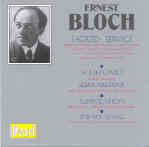Although Ernest Bloch is known to most listeners for his “Jewish music”, some of his best works (and the majority of his compositions overall) don’t deal with Jewish themes at all. But the power of Schelomo and the sweet songfulness of his shorter instrumental pieces based on traditional melodies have exerted such magnetic pull that the earlier Debussyian and later neo-classic Bloch seem to have been cast into the shadow of ethnic Romanticism. So it’s fascinating to hear Bloch the performer interpreting two of his major Jewish works with the Romantic overlay applied by other interpreters stripped away, replaced by what Harris Goldsmith in his booklet notes describes as Bloch’s “temperamental affinity for the Italian maestro’s [Toscanini’s] approach…”
Thus, Bloch’s 1950 performance of his Sacred Service is far removed from Leonard Bernstein’s: it’s swifter, without a trace of sentimentality. Rather than lingering over the attractive traditional melodies, Bloch the conductor integrates them into an overall framework that stresses, for example, the Handelian cast of the divided chorus in the “Seu Sh’orim” section or the Ravel-like colors and discipline of the radiant introduction to the “Silent Devotion” movement. Bloch completed the Sacred Service in 1933 and since it’s sung here in English with an English chorus it sometimes sounds like a British oratorio. That may be due both to Bloch’s refusal to sentimentalize and to the natural tendency of the chorus and the female soloists to revert to the familiar.
However, the major role of the Cantor is splendidly sung by bass-baritone Marko Rothmuller with impeccable English diction and a firm, rich voice. Alas, he’s too closely microphoned, sometimes covering the chorus and the backwardly placed orchestra. More jarring is the mismatched volume level that essentially divides the disc in two, with tracks 1-4 transferred at normal volume and the rest of the disc from the start of track 5 at far higher levels. Roger Beardsley’s transfers also leave much to be desired, with limited dynamics and an overall sonic dimness exacerbated by softened brass and percussion that drain some of the color from the score.
The other big work on the menu is Schelomo, Hebraic Rhapsody for cello and orchestra, Bloch’s most popular composition. Cellist Zara Nelsova recorded it three times and said this first, 1950 version with the composer was her favorite. I prefer her second one with Ansermet, primarily for the more colorfully projected orchestral part, but Nelsova plays with tremendous fire and intensity and Bloch does indeed conduct like we imagine Toscanini might have. Gone are all hints of Cinemascope orchestration. Gone too, are some of the score’s lushness and overt emotion. This may be the fastest Schelomo on disc, so if your ideal is the ruminative Rostropovich/Bernstein that makes the Rhapsody of its subtitle the central concern, you’re in for a shock. On the positive side though, this is how the composer viewed it and he may be right–there’s enough emotionalism built into the music to successfully resist excesses. The soulful shorter pieces, with Bloch at the piano accompanying Nelsova’s sensuous cello, are welcome encores.
































